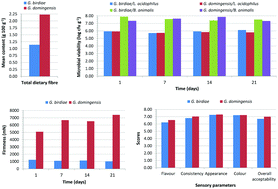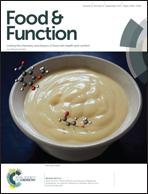Comparison of dairy desserts produced with a potentially probiotic mixed culture and dispersions obtained from Gracilaria birdiae and Gracilaria domingensis seaweeds used as thickening agents
Abstract
Dairy desserts have emerged as interesting options for the incorporation of probiotics, bioactive ingredients and alternative sources of thickeners. This shows an opportunity to investigate the use of Gracilaria seaweeds in the formulation of potentially probiotic dairy desserts. This study aimed to compare the effects of dispersions obtained from Gracilaria domingensis and Gracilaria birdiae used as thickening agents on texture properties of dairy desserts fermented with SAB 440-A, composed of the starter Streptococcus thermophilus and the potential probiotics Bifidobacterium animalis and Lactobacillus acidophilus, and also to study their physicochemical characteristics, microbial viability and sensory acceptability. No significant differences between desserts with G. birdiae or G. domingensis dispersions regarding total solids, ash and fat content, as well as pH, titratable acidity, the viability of the microorganisms of the mixed culture and sensory acceptability were verified (P > 0.05). Nonetheless, the dessert with G. domingensis dispersion showed higher dietary fibre content and significantly increased firmness than the one produced with G. birdiae (P < 0.05). Moreover, B. animalis was able to maintain higher populations, above 7 log cfu g−1 during 21 days of storage of desserts, in the presence of either G. birdiae or G. domingensis dispersions, despite the fact that L. acidophilus has shown low viability in the final products. Therefore, the G. domingensis dispersion is suitable to be used as a thickening agent to produce dairy desserts with enhanced firmness and good sensory acceptability, it being also advisable to use only B. animalis as a probiotic for this product.



 Please wait while we load your content...
Please wait while we load your content...